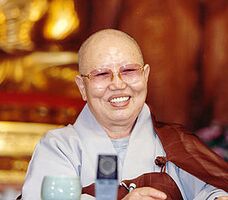Difference between revisions of "Daehaeng"
| Line 5: | Line 5: | ||
|pagename=Sunim, D. | |pagename=Sunim, D. | ||
|PersonType=Authors of English Works; Ordained (Monks and Nuns); Zen Buddhist Teachers | |PersonType=Authors of English Works; Ordained (Monks and Nuns); Zen Buddhist Teachers | ||
| + | |images=File:Daehaeng Wikipedia.jpg | ||
|MainNamePhon=Daehaeng Kun Sunim | |MainNamePhon=Daehaeng Kun Sunim | ||
|yearbirth=1927/02/03 | |yearbirth=1927/02/03 | ||
Revision as of 18:02, 24 November 2020
| English Phonetics | Daehaeng Kun Sunim |
|---|
| Birth: | 1927/02/03 |
|---|---|
| Death: | 2012/05/22 |
| Place of birth: | Seoul, Korea |
Tibetan calendar dates
- Teachers
- Hanam Jungwon
Biographical Information
Daehaeng Kun Sunim (대행, 大行; 1927–2012) was a Korean Buddhist nun and Seon (禪) master. She taught monks as well as nuns, and helped to increase the participation of young people and men in Korean Buddhism. She made laypeople a particular focus of her efforts, and broke out of traditional models of spiritual practice, teaching so that anyone could practice, regardless of monastic status or gender. She was also a major force for the advancement of Bhikkunis (nuns), heavily supporting traditional nuns’ colleges as well as the modern Bhikkuni Council of Korea. The temple she founded, Hanmaum Seon Center, grew to have 15 branches in Korea, with another 10 branches in other countries. [(https://en.wikipedia.org/wiki/Daehaeng Source Accessed Nov 24, 2020])
- Wiki Pages
- Person description or short bio
Expand to see this person's philosophical positions on Buddha-nature.
| Is Buddha-nature considered definitive or provisional? | |
|---|---|
| Position: | |
| Notes: | |
| All beings have Buddha-nature | |
| Position: | |
| If "Qualified", explain: | |
| Notes: | |
| Which Wheel Turning | |
| Position: | |
| Notes: | |
| Yogācāra vs Madhyamaka | |
| Position: | |
| Notes: | |
| Zhentong vs Rangtong | |
| Position: | |
| Notes: | |
| Promotes how many vehicles? | |
| Position: | |
| Notes: | |
| Analytic vs Meditative Tradition | |
| Position: | |
| Notes: | |
| What is Buddha-nature? | |
| Position: | |
| Notes: | |
| Svātantrika (རང་རྒྱུད་) vs Prāsaṅgika (ཐལ་འགྱུར་པ་) | |
| Position: | |
| Notes: | |
| Causal nature of the vajrapāda | |
| Position: | |
